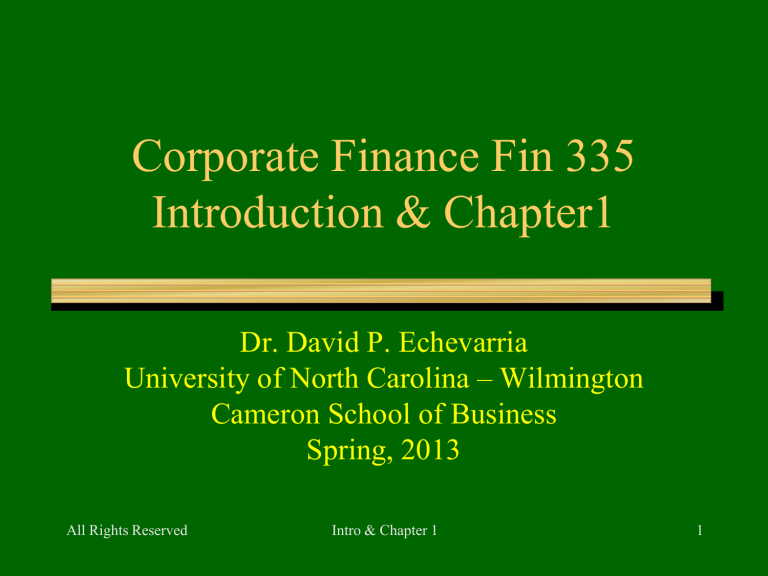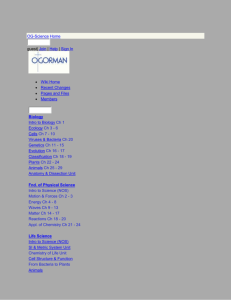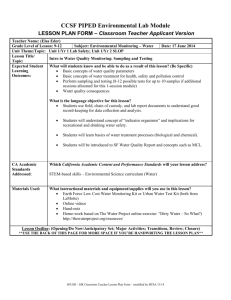Introduction to Finance Fin 100 Corporation Finance Fin 301

Corporate Finance Fin 335
Introduction & Chapter1
Dr. David P. Echevarria
University of North Carolina – Wilmington
Cameron School of Business
Spring, 2013
All Rights Reserved Intro & Chapter 1 1
Tips on getting through the CF course
A.
Skim read the assignments before class
1. Finance is a very precise set of procedures and formulas which if not followed leads to poor analysis and incorrect answers.
2. Reading the material the night before the exam will invariably lead to a poor grade.
B.
Keep up with the homework as assigned.
1. Practice helps to understand
2. Practice also helps with exams.
All Rights Reserved Intro & Chapter 1 Page 2
Tips on getting through the CF course
C.
More tips on getting through finance
1.
Don’t spend time trying to memorize formulas.
•
Understanding concepts is much more important
•
Formula sheet will be provided with each exam
•
Doing the homework helps to understand how the concepts are applied to solving finance problems.
2.
Learn to use a financial calculator (TI BA II +)
• You’ll be taught how to analyze: car leasing deals, mortgages, retirement planning, and other wealth-relevant analysis.
All Rights Reserved Intro & Chapter 1 Page 3
General Information
A.
Attendance
1.
Finance lectures involve lots of material. Missing classes results in poor exam performance.
B.
Class Participation
1.
Finance is one of the most difficult courses you will take. ASK QUESTIONS!
2.
That’s why corporations pay some of the highest salaries to those who have mastered the finer points of financial analysis & management.
All Rights Reserved Intro & Chapter 1 Page 4
General Information
C.
Course Syllabi and Lecture Notes
1. My UNCW web page: http://www.csb.uncw.edu/people/echevarriad/
•
Course Related Information
•
Course notes require Adobe Reader
•
Hyperlinks to business related web sites.
D.
1. I use email to communicate important information to students. Make certain your email account is able to receive mail.
All Rights Reserved Intro & Chapter 1 Page 5
A Thought on Exams
A.
Things Happen!
1. Take the responsible approach – keep up with the work (reading and homework)
2. Email me before the exam – we’ll work something out.
3. Failure to do so means you take Version 2
(the nightmare version).
All Rights Reserved Intro & Chapter 1 Page 6
Overview of Business Finance
Chapter 1
Goals of Financial Managers
Functions of Financial Management
Types of Business Organizations
All Rights Reserved Intro & Chapter 1 7
What’s this course about?
A.
This course is about how companies manage their capital assets and liabilities.
1.
Cash and Cash Equivalents, Receivables, and
Inventory
2.
Plant, Property, and Equipment investments
3.
Short- and Long-term debt
4.
Taxes (Federal, State, Foreign)
All Rights Reserved Intro & Chapter 1 Page 8
What’s this course about?
B.
This course is also about how companies analyze their performance
1.
Profitability: Controlling Costs
2.
Asset Management: Cash, Receivables,
Inventory, Physical Assets
3.
Capital Structure: mix of debt and equity
–
Maintain adequate solvency
All Rights Reserved Intro & Chapter 1 Page 9
Goals of Financial Managers
A. Maximizing Stockholder Wealth.
1.
Maximize stock price consistent with…
2. Minimize risk (reduce volatility of earnings)
B. Earn Economic Profits.
1. Economic Profit is a cash-basis concept.
2. Economic profits = Accounting Profits minus
Opportunity Cost of Invested Capital.
OCIC = what you could [or must] earn elsewhere
All Rights Reserved Intro & Chapter 1 Page 10
Functions of Financial Management
A. Investment/Capital Budgeting Decisions
1. Selecting from among competing investment choices.
2. Allocating capital to value enhancing projects .
B. Financing Decisions
1. Tapping capital markets.
2. Capital structure decisions.
3. Working capital management (WCM).
C. Dividend Policy
1. Retention versus payout.
2. Tax considerations.
All Rights Reserved Intro & Chapter 1 Page 11
BUSINESS ORGANIZATIONS
A. Sole proprietorships
1. Maximum personal liability.
2. 10% of total sales, 25% of total profits (USA).
3. Limited access to financial markets.
B. Partnerships
1. Personal liability depends on circumstances;
2. 10% of total sales, 10% of total profits.
3. Partnership articles are very important!
C. Corporations
1. Minimum personal liability to providers of capital.
2. 80% of total sales; 65% of total profits.
All Rights Reserved Intro & Chapter 1 Page 12
Agency and Ethics
•
Agency
– Dealing with manager – owner conflicts
– Control via contracts, annual meetings
•
Corporate Ethics
– SEC and State Regulatory oversight
– GAAP vs. Cleverly Rigged Accounting Ploys
– Sarbanes-Oxley (2002)
All Rights Reserved Intro & Chapter 1 Page 13
Homework Assignment
A.
When is a stock’s price considered to be in equilibrium?
B.
Job #1 for managers is maximizing the value of the firm. How do they accomplish this task?
C.
What are the Three major forms of business organization? What are the principal advantages/disadvantages?
All Rights Reserved Intro & Chapter 1 Page 14





